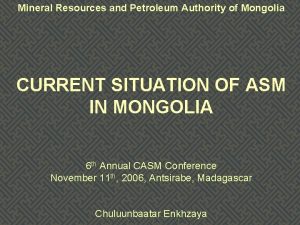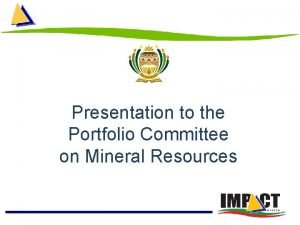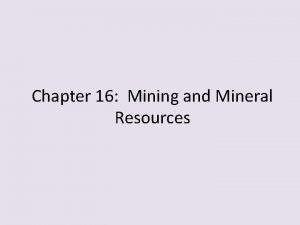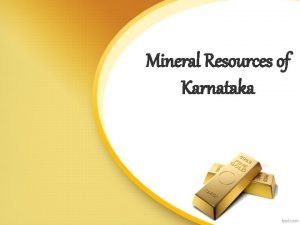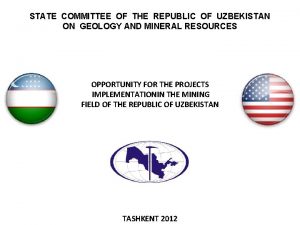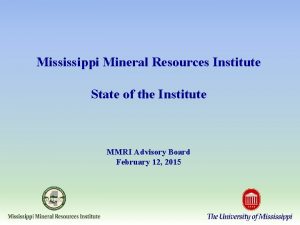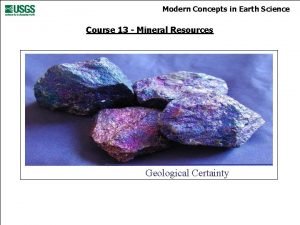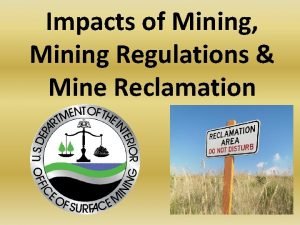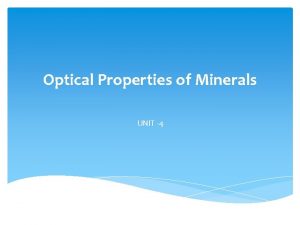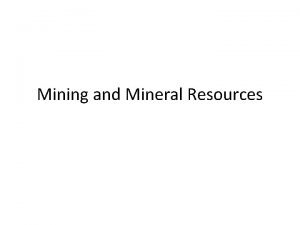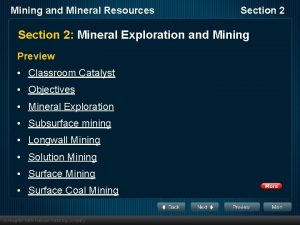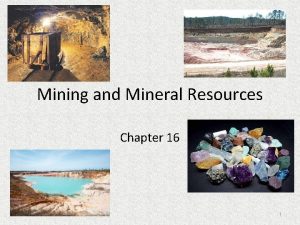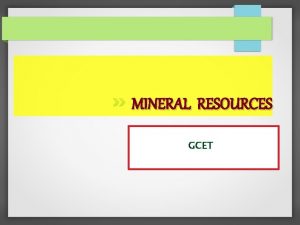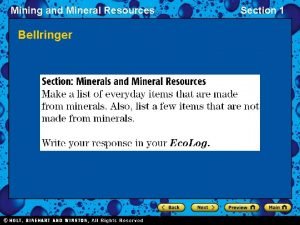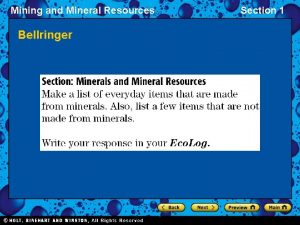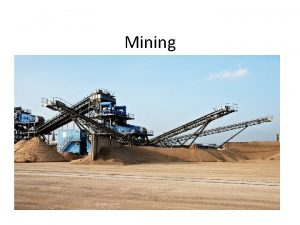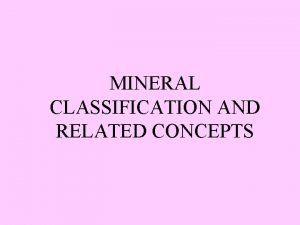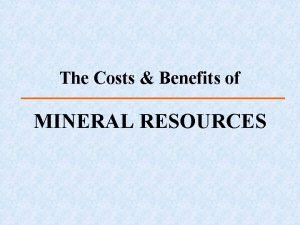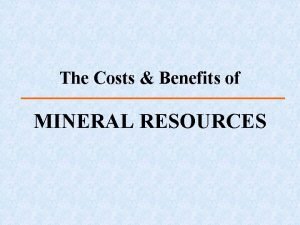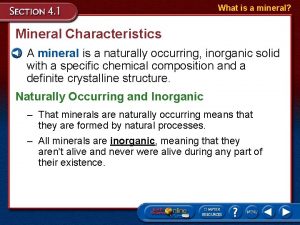Mining and Mineral Resources Section 3 Mining Regulations

















- Slides: 17

Mining and Mineral Resources Section 3: Mining Regulations and Mine Reclamation Preview • Bellringer • Objectives • The Environmental Impacts of Mining • Air and Noise Pollution • Water Contamination • Displacement of Wildlife • Erosion and Sedimentation Section 3

Mining and Mineral Resources Section 3: Mining Regulations and Mine Reclamation Preview, continued • Soil Degradation • Subsidence • Underground Mine Fires • Mining Regulation and Reclamation • State Regulation of Mining Section 3

Mining and Mineral Resources Bellringer Section 3

Mining and Mineral Resources Section 3 Objectives • Describe seven important potential environmental consequences of mining. • Name four federal laws that relate to mining and reclaiming mined land. • Define the term reclamation. • Describe two ways in which state governments regulate mining.

Mining and Mineral Resources Section 3 The Environmental Impacts of Mining • Because of the potential environmental impact of mining on a large scale, mining is one of the most heavily regulated industries in the U. S. • Mining companies spend large amounts of money to preserve the environment. • Reclaiming the land, or returning land to its original condition after mining is completed, is now a part of every surface mining coal operation.

Mining and Mineral Resources Section 3 Air and Noise Pollution • Most surface mines are not located near urban populations because of air and noise pollution. • Noise is created by equipment and by blasting. While noise may be a nuisance, blasting can cause physical damage to nearby structures. • Large amounts of dust are produced by all aspects of mining. • Regulations in the U. S. forbid mining operations to allow dust or noise to exit an area that is being mined.

Mining and Mineral Resources Section 3 Water Contamination • Water resources can be negatively impacted by mining. Water that seeps through mine sites can pick up or dissolve toxic substances. • These contaminants can wash into streams, where they can harm or kill aquatic life. • The sulfur in coal can react with oxygen and water to produce sulfuric acid, which can dissolve toxic minerals that remain in mines and excess rock. • Mining regulations in the U. S. requires companies to dispose of acid-producing rock in such a way that water is not contaminated.

Mining and Mineral Resources Section 3 Displacement of Wildlife • Removing soil from a surface mine site strips away all plant life. With their natural habitat removed, animals will leave the area. • A good development plan to reclaim a mine site can ensure that the displacement of wildlife is temporary. • Dredging a river disturbs river bottoms and destroys aquatic life. • The disturbance of a river bed can cause muddy sediments to contaminate a river for up to 10 km.

Mining and Mineral Resources Section 3 Erosion and Sedimentation • Excess rock from mines is sometimes dumped into large piles called dumps. • Running water erodes unprotected dumps and transports sediments into nearby streams. • These sediments may choke streams and damage water quality and aquatic life.

Mining and Mineral Resources Section 3 Soil Degradation • Soil at a mine site is removed from the uppermost layer downward. • When this soil is stored for later reuse, care must be taken to ensure that the upper soil layers are not buried beneath soil layers that were originally below them. • In this way, the soil layers that are richest in important nutrients are not covered.

Mining and Mineral Resources Section 3 Subsidence • Subsidence is the sinking of regions of the ground with little or no horizontal movement. • Subsidence occurs when pillars that have been left standing in mines collapse or the mine roof or floor fails. • The locations of many abandoned mines are unknown. Buildings, houses, roads, bridges, underground pipelines, and utilities that are built over these mines could be damaged if the ground below them subsides.

Mining and Mineral Resources Section 3 Underground Mine Fires • Fires that start in underground coal seams are one of the most serious environmental consequences of coal mining. • Lightning, forest fires, and burning trash can all cause coal -seam fires. Fires can also start when minerals in the coal that contain sulfur are exposed to oxygen. • These fires are hard to put out and may be left to burn themselves out, which may take decades or even centuries. • Underground fires that burn their way to the surface release smoke and gases that can cause respiratory problems

Mining and Mineral Resources Section 3 Mining Regulation and Reclamation • Mines on land in the United States are regulated by federal and state laws. • For example, mining companies must comply with the Clean Water Act and the Safe Drinking Water Act. • Mining operations must also comply with the Endangered Species Act, which ensures that mining activities will not affect threatened or endangered species and their habitats.

Mining and Mineral Resources Section 3 Reclamation • Reclamation is the process of returning land to its original condition after mining is completed. • The Surface Mining Control and Reclamation Act of 1977 created a program for the regulation of surface coal mining on public and private land. • The SMCRA also established a fund that is used to reclaim land water resources that have been adversely affected by past coal-mining activities.

Mining and Mineral Resources Section 3 State Regulation of Mining • Mining companies must obtain permits from state environmental agencies before mining a site. • State agencies are also responsible for inspecting mines to ensure compliance with environmental regulations. • Agencies issue violations to companies that do not comply with environmental regulations and assess fines for noncompliance.

Mining and Mineral Resources Math Practice Section 3

Mining and Mineral Resources Graphic Organizer Section 3
 Chapter 13 mineral resources and mining
Chapter 13 mineral resources and mining Mineral resources and petroleum authority of mongolia
Mineral resources and petroleum authority of mongolia Portfolio committee on mineral resources and energy
Portfolio committee on mineral resources and energy Mineral exploration and mining active reading
Mineral exploration and mining active reading Ameengarh
Ameengarh Uzbekistan
Uzbekistan Mississippi mineral
Mississippi mineral Falatiron
Falatiron Mining regulations
Mining regulations What is the transformation process
What is the transformation process Difference between fixed and variable resources
Difference between fixed and variable resources Symmetrical extinction of minerals
Symmetrical extinction of minerals Difference between strip mining and open pit mining
Difference between strip mining and open pit mining Text and web mining
Text and web mining Renewable resources vs nonrenewable resources
Renewable resources vs nonrenewable resources Strip mining vs open pit mining
Strip mining vs open pit mining Mining multimedia databases
Mining multimedia databases Mining complex data types
Mining complex data types

